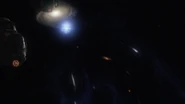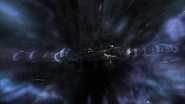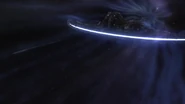(→Notes) |
m (Updating file links (automatic)) |
||
| (41 intermediate revisions by 31 users not shown) | |||
| Line 1: | Line 1: | ||
{{up|Destiny}} |
{{up|Destiny}} |
||
{{Infobox Technology |
{{Infobox Technology |
||
| − | |image=[[File: |
+ | |image=[[File:Destiny in Space.png|250px]] |
|name=Faster-Than-Light engine |
|name=Faster-Than-Light engine |
||
|manufacturer=*[[Alteran]]s (''Possibly'') |
|manufacturer=*[[Alteran]]s (''Possibly'') |
||
| Line 16: | Line 16: | ||
*[[Tau'ri]] |
*[[Tau'ri]] |
||
}} |
}} |
||
| − | {{ |
+ | {{Quote|Faster-than-light, yet not through hyperspace.|[[Nicholas Rush]]|Air, Part 1}} |
| − | The '''Faster-Than-Light engine''', or '''FTL engine''', is a technology used on the [[Ancient]] ship ''[[Destiny]]'' and the [[ |
+ | The '''Faster-Than-Light engine''', or '''FTL engine''', is a technology used on the [[Ancient]] ship ''[[Destiny]]'' and the [[Seed ship]]s sent ahead of it. It is capable of faster-than-light travel without entering [[hyperspace]]. FTL has also become a [[Tau'ri]] expression for an engine capable of travel at speeds greater than that of light, whether it is through use of hyperspace or not. |
==Overview== |
==Overview== |
||
| − | The technology behind the Faster-Than-Light engine has not been explained in detail, but does not function in the same manner as a [[hyperdrive]]. When engaged, the ship is quickly accelerated beyond the speed of light, in contrast to hyperdrive which opens a window into hyperspace. The drive's top speed has also not been made clear, though it has been shown to traverse an intergalactic void in a seemingly short amount of time |
+ | The technology behind the Faster-Than-Light engine has not been explained in detail, but does not function in the same manner as a [[hyperdrive]]. When engaged, the ship is quickly accelerated beyond the speed of light, in contrast to hyperdrive which opens a window into [[hyperspace]]. The drive's top speed has also not been made clear, though it has been shown to traverse an intergalactic void in a seemingly short amount of time. While the inter-galaxy FTL speed seems comparable to that of the [[Asgard hyperdrive]]s used on [[Tau'ri]] vessels (a few weeks to cross a void in either case), the FTL's intra-galaxy speed is also shown as much slower (taking several years to cross a galaxy, instead of about a day). What also must be taken into consideration is the fact that the FTL drives shown were heavily worn from millions of years of continuous use, so the drives top speed when it was newly constructed must have been a lot higher. This was evident when the most worn FTL generator was sabotaged, (the generator in question was hampering overall efficiency) this generator was disconnected from the ship, and as a result from that engine efficiency was greatly increased. {{cite|SGU|Sabotage|Pain}} |
| − | The ship's ability to survive FTL travel is directly dependent on its shield. Without the shield's protection, anything nearby will be instantly vaporized by the sudden energy burst. ''Destiny'' itself would also be destroyed if its shield failed mid-flight. Safeguards prevent the ship from jumping to FTL if its shield is too weak to do so; once the problem is corrected, FTL capability is restored. The shield will expand to cover objects that are latched securely onto the hull. {{cite|SGU|Earth|Divided|Intervention}} |
+ | The ship's ability to survive FTL travel is directly dependent on its [[shield]]. Without the shield's protection, anything nearby will be instantly vaporized by the sudden energy burst. ''[[Destiny]]'' itself would also be destroyed if its shield failed mid-flight. Safeguards prevent the ship from jumping to FTL if its shield is too weak to do so; once the problem is corrected, FTL capability is restored. The shield will expand to cover objects that are latched securely onto the hull, such as the [[Ancient shuttle|shuttle]]. {{cite|SGU|Earth|Divided|Intervention}} |
| − | In addition to being able to bring any ships latched to the hull into FTL, a |
+ | In addition to being able to bring any ships latched to the hull into FTL, a [[Seed ship]] has shown the ability to bring both itself and ''Destiny'' into FTL while the latter is docked to it. The reverse is likely possible, as well. The process carries the risk of destroying both ships should the structural integrity of one fail en route. The ship responsible for the jump also has full control of the ship's course. In addition; there appears to be no way for the ship being towed to judge the current course. {{cite|SGU|Resurgence}} |
| − | FTL is apparently much more sensitive to phenomena in normal space than hyperdrive is. ''Destiny's'' ability to maintain FTL seems to be dependent on a foreknowledge of the space along its course. It was brought out of FTL by the gravity well of an |
+ | FTL is apparently much more sensitive to phenomena in normal space than hyperdrive is. ''Destiny's'' ability to maintain FTL seems to be dependent on a foreknowledge of the space along its course. It was brought out of FTL by the gravity well of an [[Uncharted star]] and could not re-establish FTL flight until it passed beyond the star's range. It is believed to use the gravity wells of the stars and planets it passes near to "meander" through a galaxy, depending on data from the ancient Seed ships (sent in advance of Destiny), to determine where those stars and planets are located in each galaxy. This is likely the cause of the difficulty encountered by Dr Rush when he attempted to input manual FTL calculations. The Nakai influence on Chloe made her capable of seeing said pattern and thus calculate virtually flawless jumps into FTL. While FTL technology is impressive, it's clearly inferior to extremely rapid intergalactic hyperdrives, like those of the Asgard and the fully powered stardrives on the ancient City-Ships. A huge downside with the FTL on [[Destiny]] is that the ship must remain in and out of FTL for certain amount of time or risk the drive being severely damaged. {{cite|SGU|Faith}} |
| − | According to [[ |
+ | According to [[Dr.]] [[Nicholas Rush]], the FTL drives, once engaged, must remain active for a minimum of four hours, and remain inactive for a minimum of three hours to prevent damage to the drives. This was shown when the [[Ursini]] dropped their Seed ship out of FTL not long after entering it: they burned out their FTL drive and were unable to escape. It also requires the shields to cover the entire ship. During the [[Drone attack on Destiny]], the ship was unable to jump until the shields were repaired even after the drive was repaired. The ship can make a jump with a minimum shield strength of 5%, but any less will cause it to tear itself apart. {{cite|SGU|Aftermath|Resurgence|Deliverance|Seizure}} |
| − | An incoming wormhole to ''Destiny's'' [[Stargate]] will trigger the drive to temporarily shut down, enabling the gate to connect, but this only applies to a nine-chevron address - its rapidly changing position will quickly invalidate any seven |
+ | An incoming wormhole to ''Destiny's'' [[Stargate]] will trigger the drive to temporarily shut down, enabling the gate to connect, but this only applies to a nine-chevron address - its rapidly changing position will quickly invalidate any seven symbol address. This suggests that subspace communication is possible while the drive is in use. <span>(It should be noted that no damage to the FTL drives occurs during a dial-in from a nine-chevron address.) </span>The activation and deactivation of this device creates a disruption that momentarily interrupts communication between the [[Long-range communication device#Tau'ri device|Tau'ri version]] of the [[Ancient]] [[Long-range communication device]]s. {{cite|SGU|Air, Part 1|Earth|Lost}} |
==Notes== |
==Notes== |
||
| − | *As |
+ | *As [[Dr.]] [[Nicholas Rush]] has specifically stated that it was faster than light travel, but not through [[hyperspace]], it stands to reason that ''[[Destiny]]'' must plot a course through empty space, or it would collide with whatever is in front of it, as opposed to being in hyperspace where no planets, stars, or otherwise, exist. This may explain why ''Destiny'' takes months to cross a galaxy (where celestial bodies can obstruct ''Destiny's'' path), yet only weeks or even days to traverse intergalactic space (where there are no such obstacles). |
| − | *In the German version of the show, FTL technology is mistakenly named "Hyperdrive" just like in |
+ | *In the German version of the show, FTL technology is mistakenly named "Hyperdrive" just like in ''[[Stargate SG-1]]'' and ''[[Stargate: Atlantis]]''. |
| + | *It is possible that the drive is used on ''Destiny'' out of necessity, as the [[Ancient]]s would most certainly have [[hyperdrive]] travel by the time they built ''Destiny'', for its mission. It is likely that the pieces of the [[Cosmic microwave background radiation]] can only be collected in normal space, which the FTL engine is capable of doing as it merely travels extremely fast through it rather than entering [[hyperspace]]. This type of drive may also be more reliable than traditional hyperdrive, considering the ships must operate continuously for long periods of time without regular maintenance or repairs. |
||
==Gallery== |
==Gallery== |
||
<gallery> |
<gallery> |
||
| − | File:010.jpg|''Destiny'' moments before entering FTL. |
+ | File:010.jpg|''[[Destiny]]'' moments before entering FTL. |
| − | File: |
+ | File:Destiny_entering_FTL.png|''[[Destiny]]'' entering FTL |
| − | File: |
+ | File:normal_comiccon_trailer1_129.jpg|''[[Destiny]]'' from above |
| − | + | Faster-Than-Light engine 1.png|''Destiny'' entering |
|
| + | File:Destiny FTL Back.png|The back of ''[[Destiny]]'s'' FTL field as seen from normal space |
||
| ⚫ | |||
| − | File: |
+ | File:Destiny hyperspace.jpg|''[[Destiny]]'s'' underside |
| + | File:DestinyBack.jpg|''[[Destiny]]'s'' engines |
||
| ⚫ | |||
| + | light shift lagging effect.png|Light shift lagging effect after coming out of FTL |
||
</gallery> |
</gallery> |
||
[[Category:Drive Technology]] |
[[Category:Drive Technology]] |
||
Revision as of 23:15, 27 July 2020
- "Faster-than-light, yet not through hyperspace."
- ―Nicholas Rush[src]
The Faster-Than-Light engine, or FTL engine, is a technology used on the Ancient ship Destiny and the Seed ships sent ahead of it. It is capable of faster-than-light travel without entering hyperspace. FTL has also become a Tau'ri expression for an engine capable of travel at speeds greater than that of light, whether it is through use of hyperspace or not.
Overview
The technology behind the Faster-Than-Light engine has not been explained in detail, but does not function in the same manner as a hyperdrive. When engaged, the ship is quickly accelerated beyond the speed of light, in contrast to hyperdrive which opens a window into hyperspace. The drive's top speed has also not been made clear, though it has been shown to traverse an intergalactic void in a seemingly short amount of time. While the inter-galaxy FTL speed seems comparable to that of the Asgard hyperdrives used on Tau'ri vessels (a few weeks to cross a void in either case), the FTL's intra-galaxy speed is also shown as much slower (taking several years to cross a galaxy, instead of about a day). What also must be taken into consideration is the fact that the FTL drives shown were heavily worn from millions of years of continuous use, so the drives top speed when it was newly constructed must have been a lot higher. This was evident when the most worn FTL generator was sabotaged, (the generator in question was hampering overall efficiency) this generator was disconnected from the ship, and as a result from that engine efficiency was greatly increased. (SGU: "Sabotage", "Pain")
The ship's ability to survive FTL travel is directly dependent on its shield. Without the shield's protection, anything nearby will be instantly vaporized by the sudden energy burst. Destiny itself would also be destroyed if its shield failed mid-flight. Safeguards prevent the ship from jumping to FTL if its shield is too weak to do so; once the problem is corrected, FTL capability is restored. The shield will expand to cover objects that are latched securely onto the hull, such as the shuttle. (SGU: "Earth", "Divided", "Intervention")
In addition to being able to bring any ships latched to the hull into FTL, a Seed ship has shown the ability to bring both itself and Destiny into FTL while the latter is docked to it. The reverse is likely possible, as well. The process carries the risk of destroying both ships should the structural integrity of one fail en route. The ship responsible for the jump also has full control of the ship's course. In addition; there appears to be no way for the ship being towed to judge the current course. (SGU: "Resurgence")
FTL is apparently much more sensitive to phenomena in normal space than hyperdrive is. Destiny's ability to maintain FTL seems to be dependent on a foreknowledge of the space along its course. It was brought out of FTL by the gravity well of an Uncharted star and could not re-establish FTL flight until it passed beyond the star's range. It is believed to use the gravity wells of the stars and planets it passes near to "meander" through a galaxy, depending on data from the ancient Seed ships (sent in advance of Destiny), to determine where those stars and planets are located in each galaxy. This is likely the cause of the difficulty encountered by Dr Rush when he attempted to input manual FTL calculations. The Nakai influence on Chloe made her capable of seeing said pattern and thus calculate virtually flawless jumps into FTL. While FTL technology is impressive, it's clearly inferior to extremely rapid intergalactic hyperdrives, like those of the Asgard and the fully powered stardrives on the ancient City-Ships. A huge downside with the FTL on Destiny is that the ship must remain in and out of FTL for certain amount of time or risk the drive being severely damaged. (SGU: "Faith")
According to Dr. Nicholas Rush, the FTL drives, once engaged, must remain active for a minimum of four hours, and remain inactive for a minimum of three hours to prevent damage to the drives. This was shown when the Ursini dropped their Seed ship out of FTL not long after entering it: they burned out their FTL drive and were unable to escape. It also requires the shields to cover the entire ship. During the Drone attack on Destiny, the ship was unable to jump until the shields were repaired even after the drive was repaired. The ship can make a jump with a minimum shield strength of 5%, but any less will cause it to tear itself apart. (SGU: "Aftermath", "Resurgence", "Deliverance", "Seizure")
An incoming wormhole to Destiny's Stargate will trigger the drive to temporarily shut down, enabling the gate to connect, but this only applies to a nine-chevron address - its rapidly changing position will quickly invalidate any seven symbol address. This suggests that subspace communication is possible while the drive is in use. (It should be noted that no damage to the FTL drives occurs during a dial-in from a nine-chevron address.) The activation and deactivation of this device creates a disruption that momentarily interrupts communication between the Tau'ri version of the Ancient Long-range communication devices. (SGU: "Air, Part 1", "Earth", "Lost")
Notes
- As Dr. Nicholas Rush has specifically stated that it was faster than light travel, but not through hyperspace, it stands to reason that Destiny must plot a course through empty space, or it would collide with whatever is in front of it, as opposed to being in hyperspace where no planets, stars, or otherwise, exist. This may explain why Destiny takes months to cross a galaxy (where celestial bodies can obstruct Destiny's path), yet only weeks or even days to traverse intergalactic space (where there are no such obstacles).
- In the German version of the show, FTL technology is mistakenly named "Hyperdrive" just like in Stargate SG-1 and Stargate: Atlantis.
- It is possible that the drive is used on Destiny out of necessity, as the Ancients would most certainly have hyperdrive travel by the time they built Destiny, for its mission. It is likely that the pieces of the Cosmic microwave background radiation can only be collected in normal space, which the FTL engine is capable of doing as it merely travels extremely fast through it rather than entering hyperspace. This type of drive may also be more reliable than traditional hyperdrive, considering the ships must operate continuously for long periods of time without regular maintenance or repairs.







